A Special One-Off Expedition to...
THE TEMPLES OF ANGKOR WAT
January 24th - 31st 2026
The vast temple complexes hidden in the jungles of southeast Asia enclosing the remarkable stone artwork and archictecture is a megalithomaniacs delight. We invite you to explore with us, to witness first-hand the beauty of the Buddhist-Hindu Temples of Cambodia, including off-the-beaten-path sites, pyramids, megalithic linghams and much more to unlock their astronomical and geodetic secrets. The tour will be guided by Hugh Newman and JJ Ainsworth and special guests Arianna Mendo and Enrico Gelain.
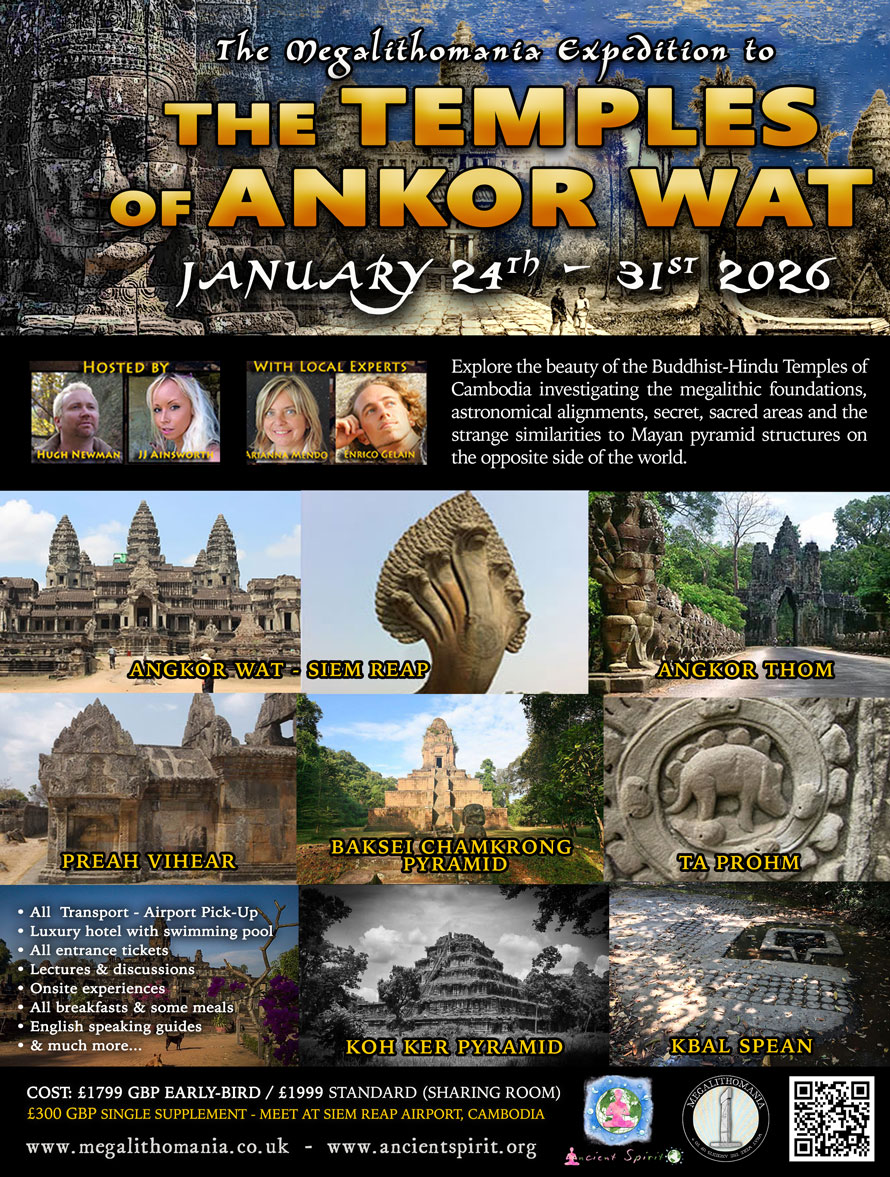
Proposed Itinerary - subject to change
Day 1 – Arrival Day
• Intl. Flights (not included), airport pick-up & hotel check-in, free time. Arrivals can also be on previous dates with pick up included anyway
• 5pm: Conference on newly discovered incredible Khmer engineering technologies (Lidar scanner, Earth Mounds, Geoglyphs)
• Welcome Dinner.

Welcome to Cambodia! Upon arrival in Siem Reap you’ll obtain your Cambodian visa on arrival, if you haven't already bought it from the app. Clear Immigration and Customs and proceed into the arrival area. You will meet your private driver for your transfer to check-in at the hotel. You may choose freely your arrival time and date in the earlier few days: just ask us and we’ll book the extra days for you at the hotel and set up the included airport transfer to the hotel based on your arrival time. Check-in, freshen up and prepare for a great trip in the Kingdom of Wonders!
In the late afternoon you will meet your hosts Enrico Gelain, Arianna Mendo, Hugh Newman and JJ and with a conference we will immediately know more about the story of the grandiose Khmer empire, similar in grandness to the Egyptian and Roman ones, with spiritual dynasties of god-kings and hundreds of megalithic buildings built, a network of thousands of kilometers of stone-paved roads and bridges stretching all over an Indochina-wide empire as well as an incredible urban-scale engineering hydraulic system able to feed a population of 1 million inhabitants, the biggest ancient pre-industrial city in the world, and all the connected cultivations at the same time. We will also know more about the newly discovered Mahendraparvata mega city in the Phnom Kulen hills and the various geoglyphs that are emerging form the jungle thanks to the Lidar technology, and the numerous newly discovered archeoastronomy alignments found all over the Cambodian temples and the temple towers themselves. Welcome Dinner together at the same luxurious and exotic restaurant where the conference took place. B.D
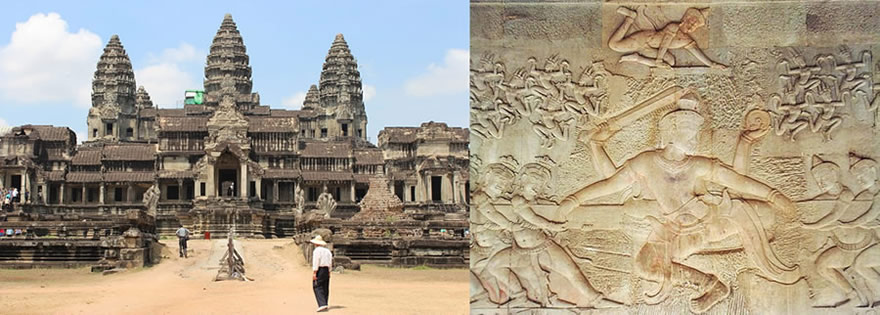
Angkor Wat - Photo Courtesy of Wikimedia Commons
Day 2 – Siem Reap – Angkor Wat
* AM: Kbal Spean bedrock carvings & dolmens
* Banteay Srei temple. Eat nearby
* PM: Beng Mealea temple & Geoglyphs
We’ll see the seeds where the kingdom was born at Kbal Spean, the place in the heart of the jungle of the highlands where the Siem Reap river spring; identified with the Naga king spirit, a gigantic mythological Indian snake being also the genius loci or 'spirit of the place', which had a key role in the creation of the Universe and in that of the Angkor kingdom. This river, with also numerous jumps and falls, became the symbol of the place where everything begins, both the Universe and their Empire: it’s a very important animist and Hindu cult place where a lot of sacred fertility and cosmic divinities symbols have been carved out of the bedrock, letting natural waters run on top of them to be consecrated with symbolic energies meanwhile they flow to carry abundance to the downwards Angkor plains. It’s also a pre-Angkor area filled with dolmens, cupmarks and animistic animals chiseled directly into the bedrock where ancient rituals were held, next to the waterfalls. B.
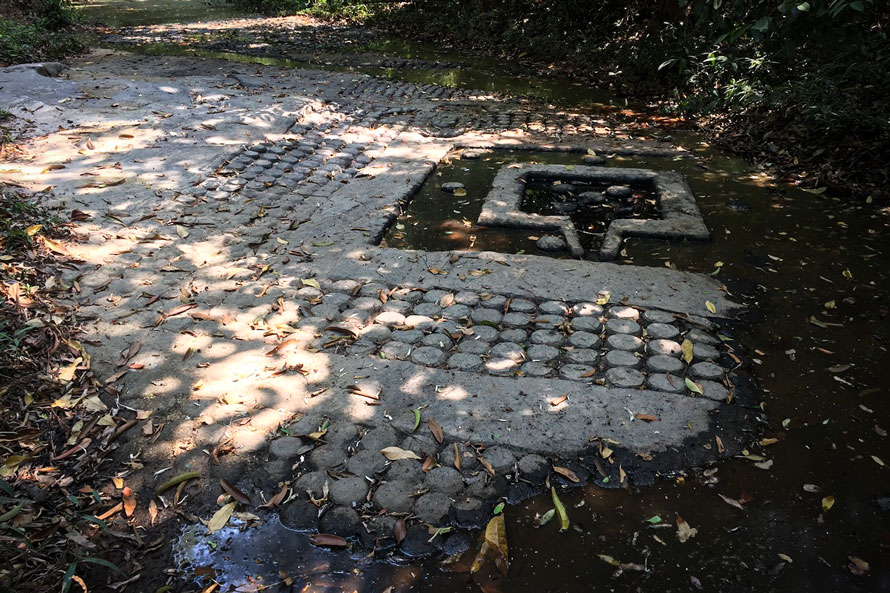
We will then experience the beauty of the wonderful Banteay Srei small temple, famous for its pink sandstones covered in very deep, detailed and intricate high reliefs, carved so deep that sometimes they almost become all-round statues peeking off the walls.
Finally today we will experience Angkor as it was when the first European explorers came here and rediscovered for the first time these incredible and exotic temples totally engulfed in the deep Indochina jungle as we enter the Beng Mealea temple, which has been left totally unrestored by the archaeologists intentionally for us to live such a wonderful experience. We’ll close the day with a 1000 Lingas earth mound field or geoglyph, the same pattern we saw this morning in Kbal Spean chiseled on the river bedrock but reproduced on a 36 hectares field.
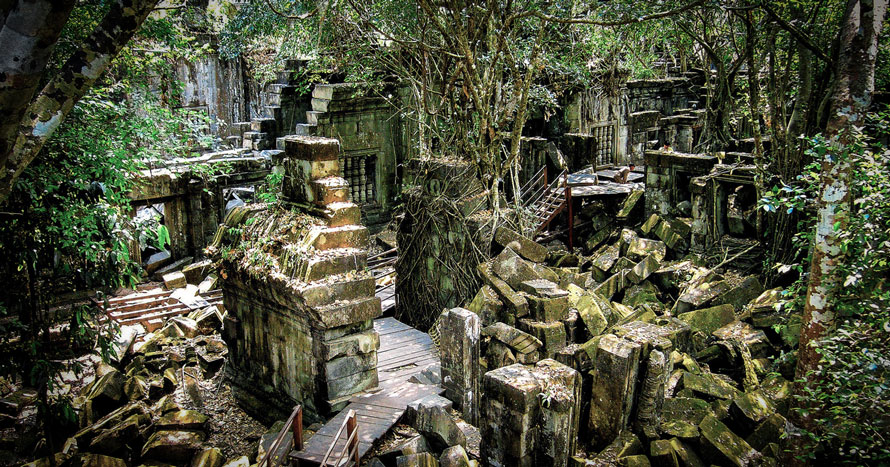
Day 3 – Angkor Wat, Phnom Bakheng Pyramid, Baksei Chamrong and Bayon temple
• AM: Angkor Wat temple & Sun and Moon archaeoastronomical alignments
• PM: Phnom Bakheng pyramid temple & ancient megalithic city
• Baksei Chamrong pyramid temple
• Angkor Thom refounded megalithic city
• Bayon temple & zenith sun alignment

The morning is set aside for a visit to the main temple, Angkor Wat. Angkor Wat is one of mankind’s greatest achievements, and the intricate 750 meters long bas-reliefs at the temple demonstrate the skill of the Khmer builders. The entire temple was constructed in the early 12th century in only 35 years, which is an incredibly short period given the fact that Angkor Wat is the biggest temple in the world, and that despite the heaviness of the structure it is literally engineeringly-speaking floating on the waters of an immense 1,92 square kilometers big mega pool. The temple itself is aligned to the Equinox, but along the 700 metres long causeway you can also see many Sun and especially Moon movements in sequence in a given timeframe.

Phnom Bakheng is the oldest temple built here, and the center of the ancient 4km2 big city of Yashodharapura. Its gigantic pyramidal structure was literally carved out of the rocky outcrop of the Bakheng hill, and then covered in fine finishing sandstone to be chiseled and decorated with complex sacred numerological, geometrical, planetary and cosmological patterns and symbols. It was built to be the omphalos, the center of the Universe, of the whole Creation and of all the various spiritual dimensions and heavens, as well as the abode of all the 33 main Hindu divinities: a very technologically complex megalithic structure and a giant reproduction of the entire Creation. Along with the Equinox alignment and other celestial phenomenas that could be observable in some Khmer temples like Angkor Wat and this one, due to a building technique that has been identified by your host Enrico Gelain, its architectural numerology is also connected to the 12 years and the 60 years Jupiter cycles.
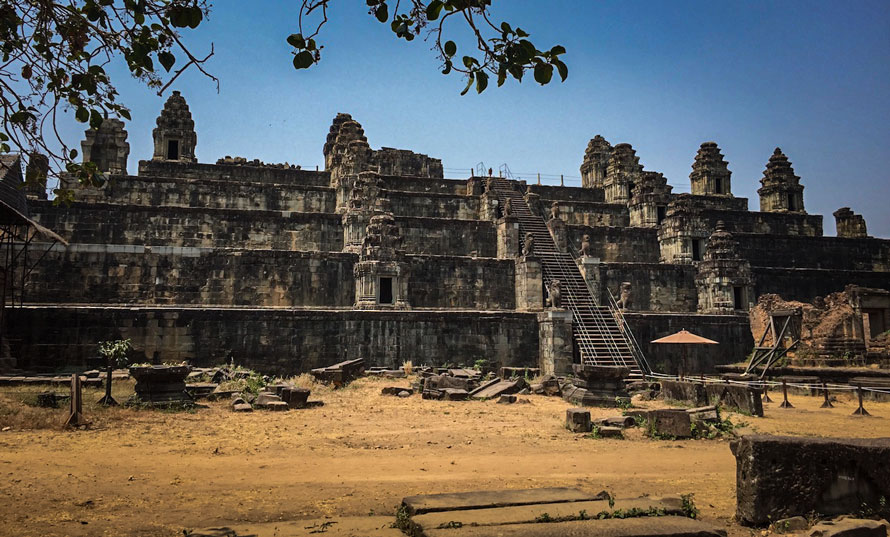
We will then explore a very Mayan-style small pyramidal structure built at the feet of the Bakheng hill, the Baksei Chamkrong, with very rare Khmer ancient carvings still preserved nowadays telling the story of the mythical origins of the pre-Angkorian kings born from a snake-like Nagini spirit.

We’ll also stop by to visit to the South Gate of the Angkor Thom city walls. Refounded after the Yashodharapura city fall, this temple/city depicts on its walls and along its avenues sacred icons that ideally traversed all the ancient city. Two rows of divinities and demons protect the bridges, avenues and road sides to access the city, pulling an enormous Naga snake which is curled around the Bayon central temple of the city, representing the Meru cosmic mount from which all Creation originated. According to G. Hancock, the whole city and the temples were built according to a centuries-long standing Khmer plan to position the main temples according to the 10.500 B.C. Spring Equinox position of the Draco constellation, representing a giant snake like the Nagas the Khmer people venerated during the animistic and Hindu periods. B.
.
Finally we’ll visit the temple of Bayon, a mountain temple with 54 towers depicting the incredible and mysterious esoteric gaze of 216 enlightened Buddha-King faces, spreading the energies of Buddhist wisdom and compassion to the 4 Cardinal Points and all over the country. According to G. Hancock, all of these numbers rely on the Equinox Precession calculations. Besides these numerologies, this temple hides one of the rarest alignment the world heard of, possible only inside the Equatorial belt of our planet.
Day 4 –Bakong pyramid temple, Linghams and Temples
• AM: Bakong pyramid temple & planets alignment
• Phnom Bok Giant Linga megalith
• Banteay Samré temple & Geoglyph
• PM: Pre Rup pyramid temple
• Optional: East Mebon temple, Angkor Wat Geoglyph

The first visit of today is the Bakong, the central temple of the Rolous temple group, a 'spun-off’ capital and one of the very earliest temple of the early Angkor era. This very tall step pyramid also has a marked resemblance with many other central American temples. Along with another Equinox and other Moon alignment at the top of the tower, according to your host Enrico Gelain this is one of the oldest temples and the most incredible one where you can observe transiting planets and make very precise astronomical calculations of their movements both along the ecliptic during the months/years, and their side-movements from the ecliptic, gaining insights on their orbital eccentricity, thanks to the 'telescope-temple’ Khmer building technique discovered by your host.
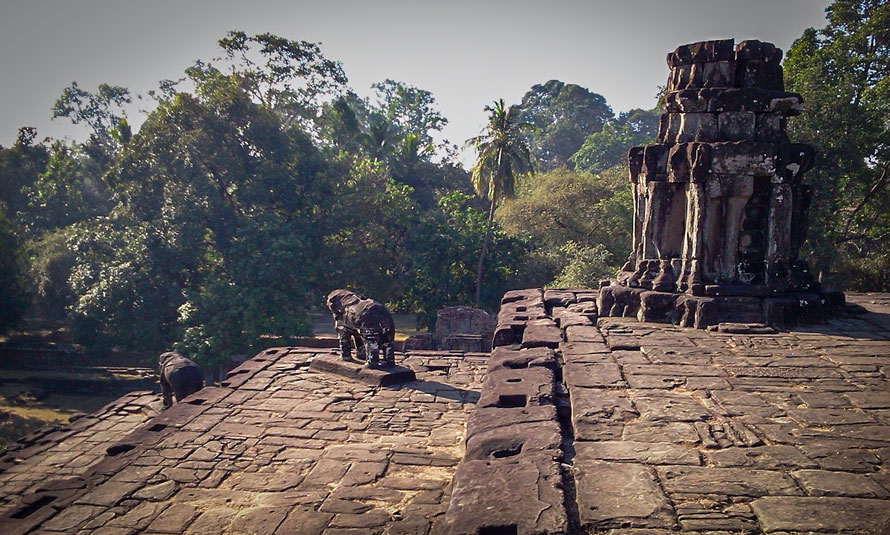
We will then visit a pre-Angkorian era mountain-temple at Phnom Bok with the biggest linga of Angkor, a giant megalith 4m high and 1,20m wide, now partially damaged, with an incredible view over the landscape and the Barays: the two giant 13km2 and almost 17km2 water reservoirs dispensing life and prosperity over the kingdom during the dry season.

After the Banteay Samré temple visit nearby with a rare Sun & Moon bas-relief, we’ll check a second 1000 Lingas earth mound field, then see the Pre Rup temple. Optionally, if we still have time, we can also see the last temple of today at the centre of the ex water reservoir, the East Mebon temple, then check if we can spot the Angkor Wat spiralling geoglyph that has been detected by the Lidar under the forest. B.
Day 5 – Ta Prohm, Bakheng & Preah Khan
• AM: Neak Poan artificial lake island pools temple
• Preah Kahn ancient city temple
• Ta Keo pyramid temple
• PM: Ta Prohm jungle temple with its mysterious dinosaur glyph
• Banteay Kdei temple
• Spectacular sunset from Srah Srang ceremonial basin
The Neak Poan is the sacred healing waters place of Angkor. It’s a rather big artificial island built in the middle of an enormous 4.5 km wide and 3,4km2 mega artificial water reservoir (which in reality is the smallest of the three Angkor water reservoirs), with other 13 artificial small sacred purification bathing and thaumaturgic lustral basins in it. Just think about the enormous earthworks they have done here!!! Of course each one of the 13 basins was connected to the 12 zodiacal signs, divided into 3 pools per each of the 4 elements, plus 1 pool representing the element Ether, and their waters were only used with a prior diagnose of the illnesses and the karmic debts of the patient through a reading of their astral chart.
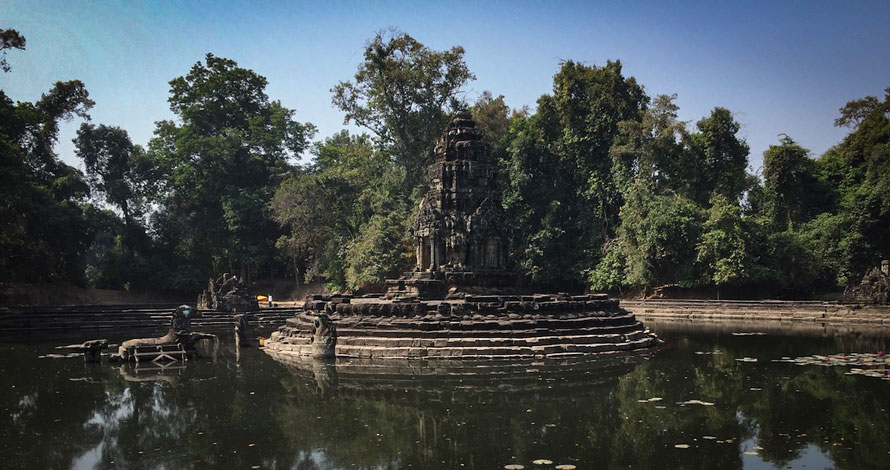
We will gaze in awe at the Preah Khan temple, with its labyrinth of hundreds of grey and pink decaying stone chapels and courtyards that are slowly being reclaimed by the jungle, with Devas and Apsaras sacred women figures reclining towards you from the walls. Large kapok trees extend limbs and roots throughout the carved stone work; while raucous parrots screech and monkeys keep watch to complete a surreal Tomb Raider picture. This is one of the few temples where you could clearly see the Equatorial alignment, and being the central chamber dark and completely covered in bronze, silver and gold with precious stones around in the past, the sun light and the light rifractions would have looked awesome those days.
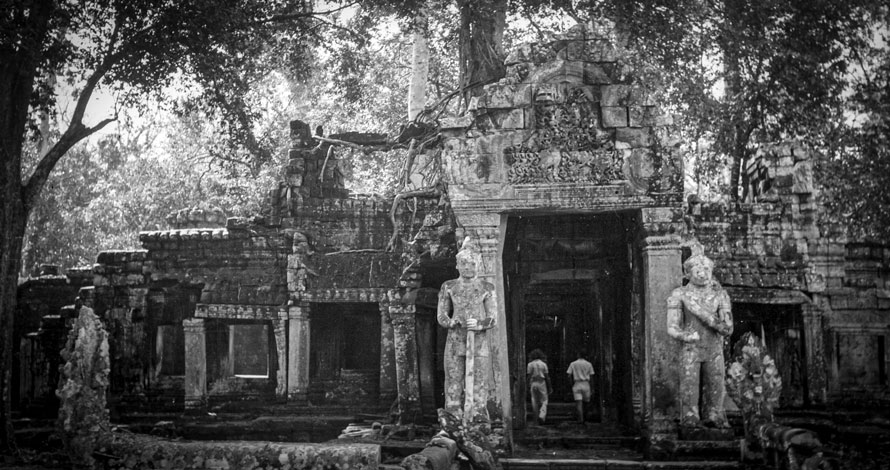
After climbing another nice and high step pyramid mountain-temple, the Ta Keo, climbable to see the lush jungles around, we’ll then be exploring the Ta Prohm, this jungle-clad temple with overgrown trees that exudes a haunting and exotic atmosphere while the magnificent roots of the trees push between the temple's huge stone blocks in a strange embrace. This temple also has the controversial Stegosaurus carving marked over it, maybe a strange decoration effect or either a legendary remembrance of a time when humans and dinosaurs lived together in ancient time.

The last exploration would be at Banteay Kdei temple, concluding the day with a spectacular sunset from the Srah Srang ceremonial basin. B.
Day 6 -Preah Vihear Temple and Koh Ker Pyramid Temples
• Preah Vihear temple hanging over a gigantic cliff
• Koh Ker pyramid temple & Extreme Northern Lunistice alignment
After breakfast at the hotel we’ll depart early today for the Preah Vihear temple, close to the Cambodia-Thailand border, at the Dangrek Mountain range. Preah Vihear is a Khmer ruin dedicated to Hindu and Buddhist deities. Upon arrival in town it's another 20 km 4WD drive to the strategically located temple, beautifully situated on top of a mountain, and for that you will rewarded with a spectacular view. The temple itself is particularly well preserved due to its location. This shrine is particularly special because of its architecture adapted to the natural environment and the religious function of the temple. The quality of the carved stone ornamentation is unique and includes cyclopean masonry suggestive of a pre-Vedic origin.
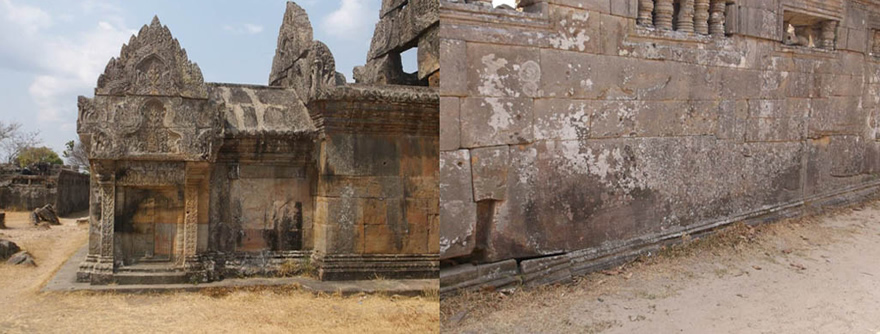
Before returning to Siem Reap, we will stop again at a less notorious, far away and less visited group of temples: Koh Ker. A very high Mayan-style step pyramid will appear in front of our eyes, actually the only 7-tiered 36m high pyramid of the Angkor empire, which once housed a 4.5m high megalithic lingam, surrounded by other 180 sanctuaries forming the ancient city of Lingapura, which once was briefly the capital of the empire, of which only two dozens are visitable due to a too thick jungle hiding them. B.L.
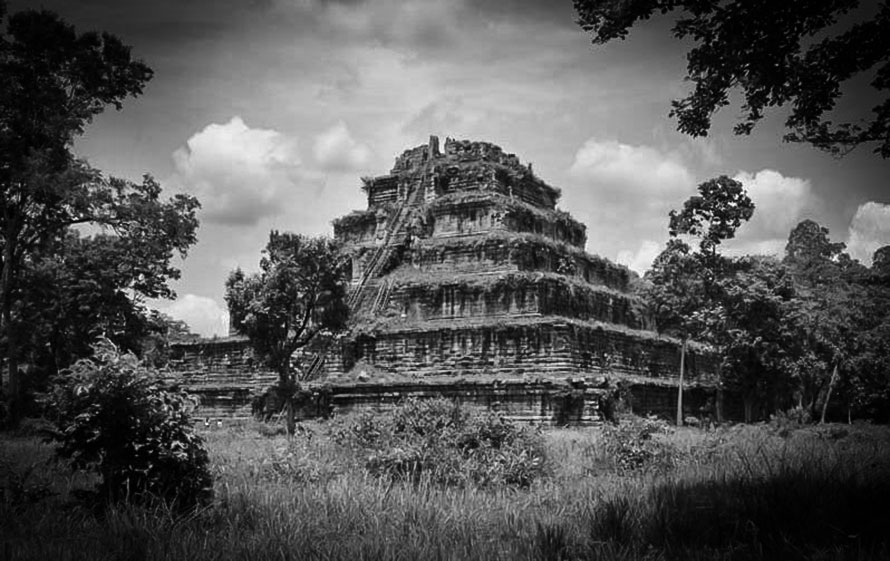
Day 7 - Last Full Day of Temples
• AM: Baphuon pyramid temple
• Phimeanakas pyramid temple
• Elephant & Leper King Terraces
• Preah Pithu X
• PM: free temple roam or shop in Siem Reap city centre
• 7pm: Farewell dinner with traditional Khmer Dances
We’ll climb the megalithic mountain pyramid temple of the Baphuon, carved right out of a rocky hill. Then, in the afternoon, we’ll explore the spiritual meaning of the two terraces of the Elephants and of the Leper King, with intricate carvings and some esoteric secrets hidden beneath the walls. The last unclimbable Phimeanakas pyramid temple will disclose us the secret nightly rituals that the king performed each full moon to connect the kingdom to the fertility promised by the half-serpent female Nagini spirit, daughter of the Naga king and genius loci of the area. Nearby, an enormous sacred stone pool accessible only by the kings is chiseled with mythological water beings, where the kings could bathe together with their gods. You can conclude the tour with a free temple roam inside the park or go shopping in Siem Reap city centre for the rest of the afternoon.
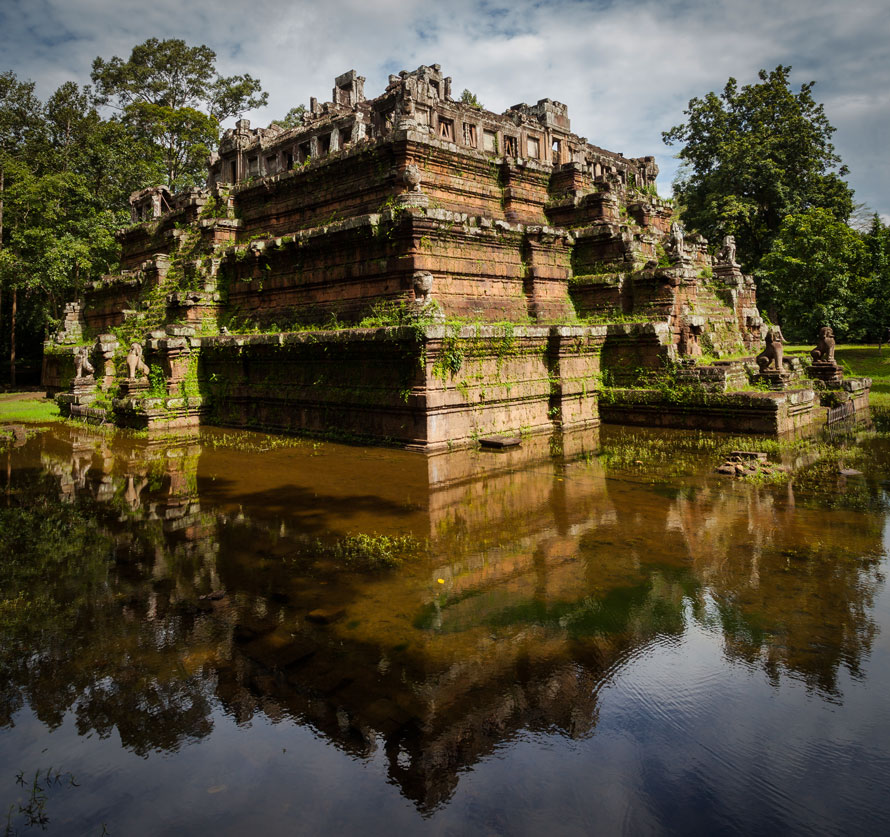
We’ll good bye ourselves with a gorgeous evening Farewell Dinner, enjoying an Apsara Dance Show with typical khmer cuisine and a wonderful traditional dance show with modern ethnic and historical mythological dances of the Apsaras, the sacred female dancers of the Indian mythology which paraded along the temple corridors during the apogee of the Khmer Empire. B.D.
Day 8 -Siem Reap - Home
AM: Airport drop-off for the intl. flights
You may choose freely your departure time and date in the few days after: just ask us and we’ll book the extra days for you at the hotel and set up the included hotel transfer to the airport based on your departure time. See you soon Cambodia! B.

INCLUDING:
- All transfers and transport as per the program:
- All accommodations as per program (based on 1 double/triple sharing room)
- Meals as mentioned (B=breakfast, L=lunch, D=dinner).
- Service English speaking station guides as mention in itinerary
- All Entrance fees on tour
- Water & Tissues
Contact and info email HERE
|
NOT INCLUDING:
- Air tickets: domestic and international (see below)
- Insurance
- Early check-in and late check-out
- Personal expenses
- All drinks
- Visa fees and/or visa authorization
- Tips
- Other expenses that not mentioned on the itinerary
|
BOOK DEPOSIT HERE
|
|
Conditions:
1) All Paypal fees and international bank costs must be taken care of by the buyer. These will be added on final payment. We cannot take on these costs as we are keeping the prices right down to create an affordable tour.
2) Megalithomania cannot refund from 60 days before start of tour if you cancel.
3) Megalithomania will refund 50% if you cancel up until 60 days prior to the tour (this does not include deposit).
4) Deposits are Non-refundable.
5) Megalithomania cannot be held responsible for any injury, accident or stolen goods - please get travel insurance and relevant visas before booking this tour and have a passport with at least 3 months past the end date of the tour.
6) Full payment and passport details must be received by December 1st 2025
7) Roommates: We are happy to try to and match our guests with a suitable roommate for those who are traveling alone. If we are unable to do this, you will be responsible to pay for the single supplement. Early registration will facilitate this process.
8) Please hold off booking your international flights, until the tour is confirmed in writing via email. We cannot be held responsible for any costs incurred. Please email for further details - info@megalithomania.co.uk
9) Itinerary may be subject to change if circumstances arise beyond reasonable control.
10) Megalithomania accepts no responsibility for losses or incidental expenses due to delay or change in schedules, hotel booking irregularities, defaults, accidents, sickness, quarantine, emergency, weather, strikes, war, travel restrictions, or other causes. All such losses are the sole responsibility of the participants. Please make sure you have travel insurance to cover all this.
11) Force Majeure: Megalithomania LTD is not accountable; nor legally responsible, will not pay you any reimbursement if our obligations have been affected by any unforeseen circumstances that we are not able to avoid. Hereunder; we will list examples but not limited items of the force majeure cases: War, threat of war, terrorist activities, virus outbreaks, quarantine, civil discord with its consequences or the risk of such activity, riot, airport closure, natural or atomic disasters, fire, chemical or biological disasters and adverse weather, sea, ice and river conditions, and/or similar occasions. |
|